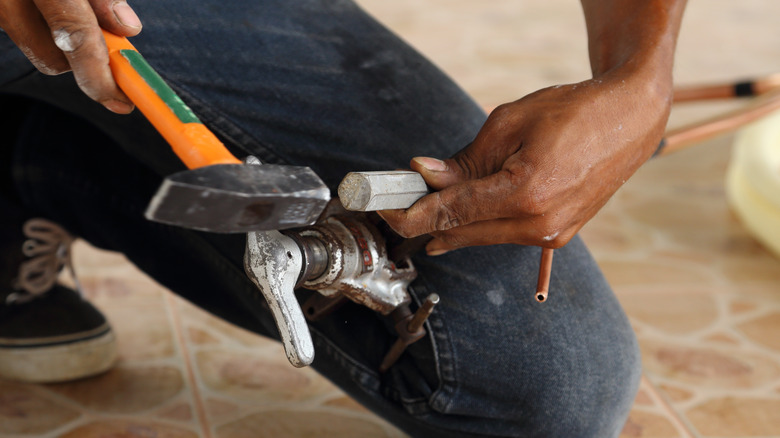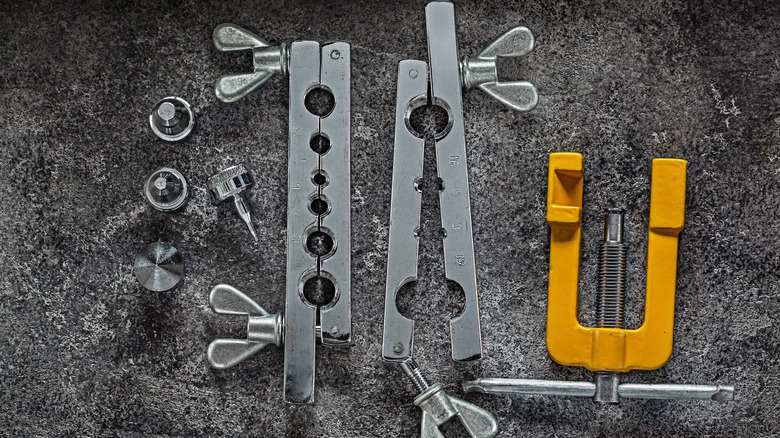What Is A Swage Tool Used For?
Even to the most dedicated home improvement DIYers, the working of copper pipe can be something of a mystery — an obscure, vaguely antiquated art like playing a lute or messing about with sourdough. We might get comfortable gluing together PVC or crimping PEX, but the idea of bending or soldering (or brazing) together metal pipes seems kind of mad. And nowhere is this madness more evident than in the use of a swaging tool to make a pipe larger. You read that right. The idea is to use a tool to expand a copper pipe's diameter so that another pipe of its original size can slide into it and be soldered, forming a strong joint.
It seems like the province of a blacksmith or maybe even an alchemist, but swaging is a common task for which there are common tools that can be used by plumbers, HVAC professionals, and even DIYers to transmute copper into the gold standard of pipe-fitting: the swaged joint. There are a handful of ways to get two pipes together that involve deforming the pipe: crimping (also known as press-fitting), flaring, and swaging. All involve applying pressure to the tube or pipe from the inside, but they do it in very different ways.
Swaging versus crimping and flaring
Swaging is expanding a copper pipe into a sleeve into which another pipe fits, with the pair soldered or brazed to form a very strong joint. Flaring has some similarities, and is often confused with swaging because one of the most common tools used for swaging and flaring is nearly identical. Flaring produces a flared or cone-shaped section of pipe rather than a cylindrical one. The flare makes the tube fit into a flare fitting so that it will not leak, while swaging doesn't make use of fittings. Flaring is difficult and best avoided by most hobbyists, which is why DIY mini-split air conditioners that can be installed with no existing ductwork now use a quick-connect technology rather than flared tubes in their refrigerant linesets.
Press-fit crimping (often referred to by the trade name ProPress) is a comparatively new technology for joining pipes of various materials by crimping a ProPress fitting onto each of the pipes. It is similar to Sharkbite connectors in that ProPress fittings rely on an internal EDPM O-ring, and it's similar to crimping PEX in that it involves contracting the fitting to seal the joint. (Sealing joints in PEX, a plastic pipe that's an important alternative to copper, is also called crimping.) Crimping is much faster than soldering and is said to be quite durable, but some argue that soldering and brazing are just as effective (but still slow) when performed by a skilled tradesperson.
The types of swaging tools
There are a number of different sorts of swage tools that are commonly used for swaging pipes, and they're easiest to differentiate by looking at how the necessary force is delivered. The simplest makes use of the force delivered by a hammer to drive a spike-shaped punch (they're usually shaped more like a stepped drill bit) into a pipe or tube to expand it. The next most common means of swaging is probably the use of feed screws to drive a swaging bit into the pipe. Feed screw swaging tools are indistinguishable from flaring bar tools, except for the shape of the dies used to do the expansion. Both manual tube expanders (handheld units that look something like pop-rivet guns) and spin swagers (drill-attached bits that rotate inside and press against a tube) use rotation and manual mechanical force to expand tubes.
Hydraulic tube expanders use water pressure (inside a bladder or otherwise contained) to enlarge tubes and pipes. Hydraulic swagers are mostly used for tubes rather than pipes but might damage smaller tubes. Hydraulic swaging is increasingly common, but some other swaging technologies are not. These include explosive, electrohydraulic, and electromagnetic forming, which are primarily used in industrial and scientific settings and aren't even available to plumbers and HVAC wizards.

